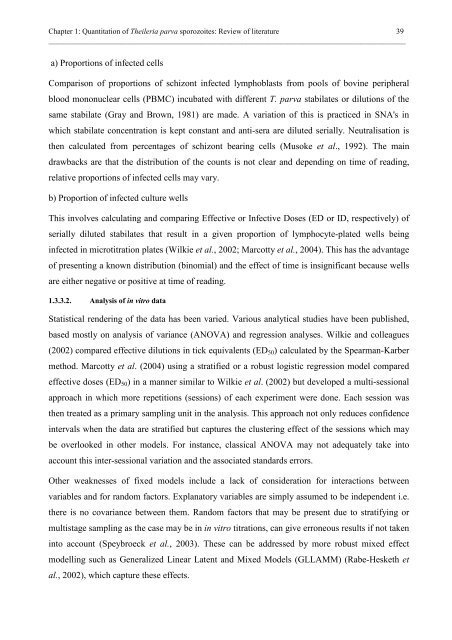In vitro quantitation of Theileria parva sporozoites for use - TropMed ...
In vitro quantitation of Theileria parva sporozoites for use - TropMed ...
In vitro quantitation of Theileria parva sporozoites for use - TropMed ...
Create successful ePaper yourself
Turn your PDF publications into a flip-book with our unique Google optimized e-Paper software.
Chapter 1: Quantitation <strong>of</strong> <strong>Theileria</strong> <strong>parva</strong> <strong>sporozoites</strong>: Review <strong>of</strong> literature 39<br />
______________________________________________________________________________________________<br />
a) Proportions <strong>of</strong> infected cells<br />
Comparison <strong>of</strong> proportions <strong>of</strong> schizont infected lymphoblasts from pools <strong>of</strong> bovine peripheral<br />
blood mononuclear cells (PBMC) incubated with different T. <strong>parva</strong> stabilates or dilutions <strong>of</strong> the<br />
same stabilate (Gray and Brown, 1981) are made. A variation <strong>of</strong> this is practiced in SNA's in<br />
which stabilate concentration is kept constant and anti-sera are diluted serially. Neutralisation is<br />
then calculated from percentages <strong>of</strong> schizont bearing cells (Musoke et al., 1992). The main<br />
drawbacks are that the distribution <strong>of</strong> the counts is not clear and depending on time <strong>of</strong> reading,<br />
relative proportions <strong>of</strong> infected cells may vary.<br />
b) Proportion <strong>of</strong> infected culture wells<br />
This involves calculating and comparing Effective or <strong>In</strong>fective Doses (ED or ID, respectively) <strong>of</strong><br />
serially diluted stabilates that result in a given proportion <strong>of</strong> lymphocyte-plated wells being<br />
infected in microtitration plates (Wilkie et al., 2002; Marcotty et al., 2004). This has the advantage<br />
<strong>of</strong> presenting a known distribution (binomial) and the effect <strong>of</strong> time is insignificant beca<strong>use</strong> wells<br />
are either negative or positive at time <strong>of</strong> reading.<br />
1.3.3.2. Analysis <strong>of</strong> in <strong>vitro</strong> data<br />
Statistical rendering <strong>of</strong> the data has been varied. Various analytical studies have been published,<br />
based mostly on analysis <strong>of</strong> variance (ANOVA) and regression analyses. Wilkie and colleagues<br />
(2002) compared effective dilutions in tick equivalents (ED 50 ) calculated by the Spearman-Karber<br />
method. Marcotty et al. (2004) using a stratified or a robust logistic regression model compared<br />
effective doses (ED 50 ) in a manner similar to Wilkie et al. (2002) but developed a multi-sessional<br />
approach in which more repetitions (sessions) <strong>of</strong> each experiment were done. Each session was<br />
then treated as a primary sampling unit in the analysis. This approach not only reduces confidence<br />
intervals when the data are stratified but captures the clustering effect <strong>of</strong> the sessions which may<br />
be overlooked in other models. For instance, classical ANOVA may not adequately take into<br />
account this inter-sessional variation and the associated standards errors.<br />
Other weaknesses <strong>of</strong> fixed models include a lack <strong>of</strong> consideration <strong>for</strong> interactions between<br />
variables and <strong>for</strong> random factors. Explanatory variables are simply assumed to be independent i.e.<br />
there is no covariance between them. Random factors that may be present due to stratifying or<br />
multistage sampling as the case may be in in <strong>vitro</strong> titrations, can give erroneous results if not taken<br />
into account (Speybroeck et al., 2003). These can be addressed by more robust mixed effect<br />
modelling such as Generalized Linear Latent and Mixed Models (GLLAMM) (Rabe-Hesketh et<br />
al., 2002), which capture these effects.











